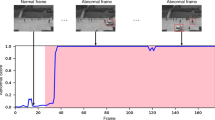Abstract
Video compression standard H.264/AVC outperforms previous standards in terms of coding efficiency but at the cost of higher computational complexity. In H.264/AVC, the variable block size full motion estimation is the most time-consuming operation. This paper presents a method to reduce the complexity of motion estimation in two stages. The first stage exploits the similarities between frames for early SKIP mode decision for a macroblock (MB) based upon a criteria formulated on the basis of the statistics of the frame difference residues. MBs that fail to qualify for the SKIP mode in the first stage spills over to the second stage where mode decision depends upon the number of zero blocks (ZB) in the MB. The study of the full search motion estimation on different sequences show that there is a strong dependence between the number of ZBs in a MB and the likelihood of a particular mode being selected. The proposed algorithm utilizes this relationship for early mode decision for a MB. The algorithm is evaluated using a wide range of test sequences from different classes. Experimental results show that the proposed algorithm gives considerable saving in encoding time and search points in the range of 36–87%. Furthermore, despite the reduction in computational complexity, the coding efficiency (picture quality and bitrate) in the proposed method is comparable to the H.264/AVC standard software Joint Model (JM12.4).
Similar content being viewed by others
References
Joint Video Team of ITU-T and ISO/IEC JTC 1: Draft ITU-T recommendation and final draft international standard of joint video specification (ITU-T Rec. H.264 | ISO/IEC 14496-10 AVC), document JVT-G050r1 (2003)
Wiegand T., Sullivan G.J., Bjontegaard G., Luthra A.: Overview of the H.264/AVC video coding standard. In:IEEE Trans. Circuits Syst. Video Technol. 13(7), 560–576 (2003)
Richardson I.E.G.: H.264 and MPEG-4 Video Compression: Video Coding for Next-Generation Multimedia. Wiley, London (2003)
Wiegand T., Schwarz H., Joch A., Kossentini F., Sullivan G.J.: Rate-constrained coder control and comparison of video coding standards. In:IEEE Trans Circuits Syst. Video Technol. 13(7), 688–703 (2003)
Sousa L.A.: General method for eliminating redundant computations in video coding. Electron. Lett. 36, 306–307 (2000)
Kim, G.Y., Moon, Y.H., Kim, J.H.: An early detection of all-zero DCT block in H.264. In: Proceedings of the International Conference on Image Processing (ICIP), vol. 1, pp. 453–456 (2004)
Moon Y.H., Kim G.Y., Kim J.H.: An improved early detection algorithm for all-zero blocks in H.264 video encoding. In:IEEE Trans. Circuits Syst. Video Technol. 15(8), 1053–1057 (2005)
Wang H., Kwong S., Kok C.-W.: An efficient mode decision algorithm for H.264/AVC encoding optimization. In:IEEE Trans. Multimed. 9(4), 882–888 (2007)
Wu D. et al.: Fast intermode decision in H.264/AVC video coding. In:IEEE Trans. Circuits Syst. Video Technol. 15(6), 953–958 (2005)
Zeng H., Cai C., Ma K.-K.: Fast mode decision for H.264/AVC based on macroblock motion activity. IEEE Trans. Circuits Syst. Video Technol. 19(1), 1–11 (2009)
Liu Z., Shen L., Zhang Z.: An efficient intermode decision algorithm based on motion homogeneity for H.264/AVC. IEEE Trans. Circuits Syst. Video Technol. 19(1), 128–132 (2009)
Kim, D., Kim, J., Jeong, J.: Adaptive macroblock mode selection for reducing the encoder complexity in H.264. In: ACVIS, number 4179 in LNCS, pp. 396–405 (2006)
Jing X., Chau L.-P.: Fast approach for H.264 inter mode decision. Electron. Lett. 40(17), 1050–1052 (2004)
Sullivan, G., Bjontegaard, Gisle.: Recommended simulation common conditions for H.26L coding efficiency experiments on low-resolution progressive-scan source material. ITU-T VCEG, Doc. VCEG-N81, pp. 1–3 (2001)
Bjontegaard, G.: Calculation of average PSNR difference between RD-curves. ITU-T VCEG, Doc. VCEG-M33, pp. 1–2 (2001)
Ma, K., Qiu G.: An improved adaptive rood pattern search for fast block-matching motion estimation in JVT/H.26L. In: Proceedings of the IEEE International Symposium on Circuits and Systems (ISCAS), vol. II, pp. 708–711 (2003)
Author information
Authors and Affiliations
Corresponding author
Rights and permissions
About this article
Cite this article
Ganguly, A., Mahanta, A. Improved mode decision algorithm based on residues and early zero block detection in H.264/AVC. SIViP 8, 299–305 (2014). https://doi.org/10.1007/s11760-012-0291-7
Received:
Revised:
Accepted:
Published:
Issue Date:
DOI: https://doi.org/10.1007/s11760-012-0291-7




